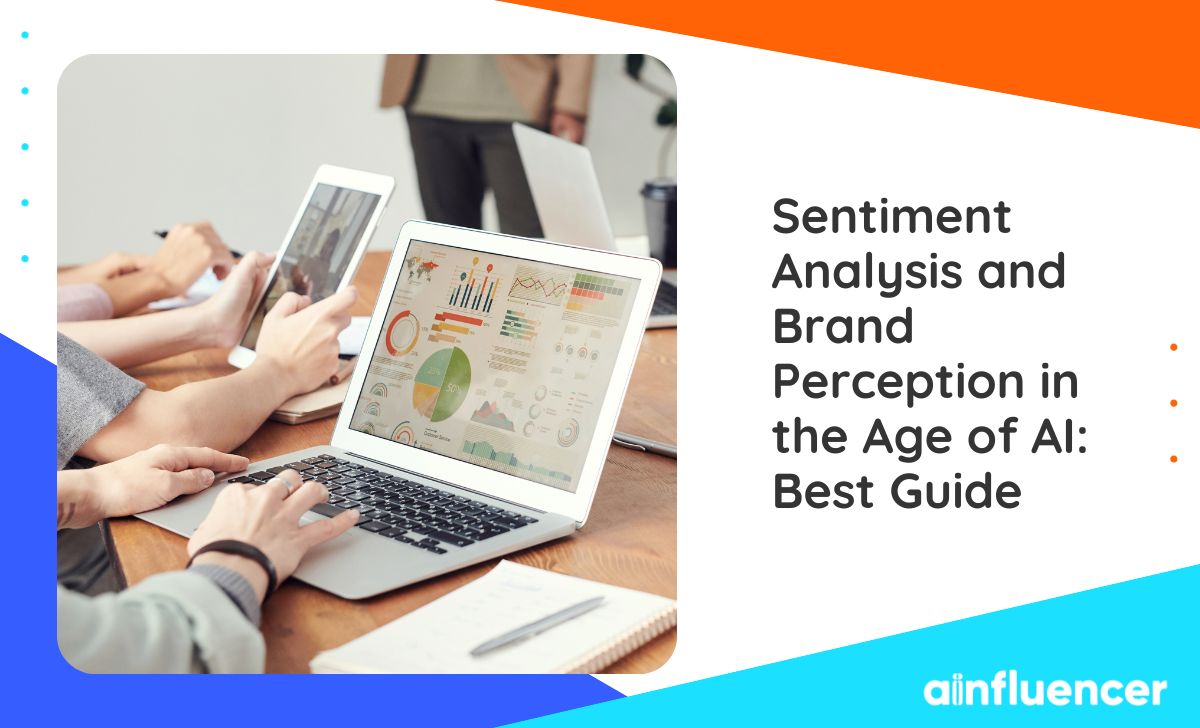Every click, like, and comment can signify a consumer’s sentiment. Understanding these emotions has never been more crucial for businesses. Sentiment Analysis, a technique that deciphers these emotions from vast amounts of unstructured data, has emerged as a game-changer in this landscape.
But as the volume of data continues to grow exponentially, traditional methods of sentiment analysis struggle to keep up. Now AI tools have significantly enhanced the accuracy and efficiency of said analysis.
So in this post, we’ll talk about Sentiment Analysis in the context of AI, exploring its significance, workings, and the profound impact it has on brand perception.
What Exactly Is AI Sentiment Analysis
Imagine you’ve just launched a new product, and you’re eager to know what people think about it. You could go through every tweet, every review, and every comment on your blog, but that would be time-consuming and, let’s face it, a bit overwhelming.
This is where sentiment analysis and AI marketing come into play. Sam McKay, CEO of Enterprise DNA, says, “At its core, sentiment analysis is like having a super-smart assistant who reads through all those comments and tells you, “Hey, 70% of the people love our new product, but 30% had issues with its battery life.”
Now, traditionally, this type of analysis was done manually. Teams would sift through data, categorize comments as positive, negative, or neutral, and then draw conclusions.
This digital marketing strategy was effective to some extent but had its limitations.
For one, it was slow. By the time you finished analyzing feedback about a marketing campaign, you’d probably already started your next one. Secondly, human bias could creep in. One person might interpret a comment as negative, while another might see it as neutral.
But with advancements in technology, we now have algorithms that can process vast amounts of data in mere seconds. More importantly, they can understand the context.
Example
For instance, consider the statement, “The phone’s design is killer.” A traditional system might flag this as negative because of the word “killer.” In contrast, an AI system would recognize it as a positive sentiment, understanding that “killer” in this context means “impressive” or “excellent.”
But it’s not just about speed and accuracy. AI systems can also detect nuances in emotions. Instead of just categorizing feedback as positive or negative, they can identify if a customer is “elated,” “satisfied,” “frustrated,” or “disappointed.”
This level of detail is invaluable. Knowing that a customer is ‘disappointed’ rather than just ‘negative’ can provide insights into the exact aspects of a product or service that might need tweaking.
Check the example by Repustate:
So in a nutshell, while traditional sentiment analysis gave us a basic idea of public opinion, AI-powered analysis provides a detailed, nuanced, and real-time understanding. It’s like the difference between getting a weather update that says it’s going to rain and one that tells you when it’s going to rain, how long it will last, and how heavy it will be. The latter is obviously more informative and actionable.
What Are the “The Mechanics” Involved in AI-Powered Sentiment Analysis
So how does it all work? Let’s break down the mechanics.
Natural Language Processing (NLP) and its Role
At the heart of AI-powered sentiment analysis is Natural Language Processing, or NLP. Think of NLP as the bridge between human language and computer understanding.
Tiffy Cu, Travel Blogger at Asiatravelbug, simplifies this, “When we humans communicate, we use a lot of context, idioms, and cultural references.
For a computer, phrases like “spill the beans” or “hit the books” can be baffling. NLP helps machines interpret these phrases in the way humans intend them.”
For instance, if someone tweets, “Just tried the new burger at XYZ restaurant, and I’m on cloud nine!”, NLP helps the system understand that “on cloud nine” means the person is extremely happy, and it’s not about any actual cloud or the number nine.
Machine Learning and Pattern Recognition
“While NLP helps computers understand human language, machine learning ensures that the system gets better over time. Machine learning is like teaching a child through repetition and correction”, says Christine Evans, Sr. Director, Marketing Communications at FICTIV.
Initially, the system might not recognize the sentiment behind more complex statements.
However, as it processes more data and receives corrections, it learns and improves.
Pattern recognition plays a pivotal role here. Over time, the system starts recognizing patterns in the way people express sentiments. For example, it might be noticed that phrases like “not too shabby,” “pretty decent,” and “not bad at all” often indicate a mildly positive sentiment, even though they might sound somewhat negative out of context.
The Evolution of AI Algorithms in Understanding Nuanced Emotions
“The early days of AI sentiment analysis were pretty black and white. Comments were either positive, negative, or neutral. But emotions are complex.
Today’s advanced AI algorithms can detect a spectrum of emotions, from “ecstatic” and “pleased” to “annoyed” and “furious.”, explains Martin Seeley, CEO of Mattress Next Day.
This evolution is a result of both more sophisticated algorithms and the vast amount of data available for training. As AI systems process more diverse expressions of sentiment from different cultures, age groups, and contexts, they become adept at understanding even the most nuanced emotions.
For instance, they can differentiate between “I’m disappointed” (a mild negative sentiment) and “I’m livid” (a strong negative sentiment).
Moreover, with advancements in technology, AI systems can now pick up on subtleties like sarcasm, which was once a significant challenge. A statement like “Oh, great! Another flat tire!” would be recognized as negative, even though the word “great” is typically positive.
So basically, the mechanics behind AI-powered analysis are a blend of NLP, machine learning, and ever-evolving algorithms. Together, they transform a machine into an almost empathetic entity, capable of understanding human emotions with remarkable accuracy.
What Does This Mean for You as a Brand Today
Today, businesses are constantly seeking ways to understand their customers better, so they can improve their products, and sharpen their brand image.
Sentiment analysis, with its ability to gauge public emotion, has become an invaluable tool for companies across industries.
Here are its key applications for your business:
#1 Social Media Monitoring and Brand Perception
Imagine launching a new product and wanting to gauge the initial reactions without sifting through thousands of tweets, Instagram comments, or Facebook posts.
This analysis does precisely that. By analyzing the sentiments behind social media posts, businesses can get a pulse on how their product is received, what features are loved, and what aspects might need a revisit.
But it’s not just about products.
Companies can also monitor their overall brand perception.
Are people talking positively about your brand after a recent ad campaign?
Or has there been a surge in negative sentiments after a controversial company statement?
Sentiment analysis provides these insights, allowing you to adjust strategies in real time.
#2 Enhanced Customer Service Experiences
We’ve all been there – waiting in line to voice a complaint or seeking a solution to a product issue. Now, imagine if the customer service representative already knew your sentiment before you spoke a word. With sentiment analysis, this is becoming a reality.
Ritika Asrani, Owner and Broker of Century21 St Maarten Real Estate, explains, “By analyzing the tone, choice of words, or even the speed of speech, AI systems can gauge a customer’s emotion during a call.
If a customer sounds frustrated, the system can alert the representative, who can then approach the conversation with added empathy or even escalate the issue if needed.”
This proactive approach not only resolves issues faster but also ensures customers feel heard and valued.
#3 Brand Monitoring Across Various Platforms
“While social media is a significant part of the digital landscape, it’s just the tip of the iceberg. Customers voice their opinions on blogs, review sites, forums, and even in the comment sections of online news articles.”, adds Eric Eng, CEO and Founder of AdmissionSight.
For businesses, keeping track of all these platforms manually is a Herculean task. Sentiment analysis simplifies this. By continuously monitoring various platforms, it provides a holistic view of brand perception.
Did a blogger write a glowing review about your product? Or did a forum thread highlight a recurring issue with your service?
This type of analysis captures these nuances, ensuring businesses never miss a beat in the vast digital conversation.
#4 Market Research and Competitor Analysis
In the competitive world of business, staying ahead means not just understanding your own brand but also keeping a close eye on the market and competitors. Sentiment analysis serves as a powerful ally in this mission.
Sumeer Kaur, Founder of Lashkaraa.com, explains, “When launching a new product or entering a new market segment, businesses traditionally rely on surveys, focus groups, and pilot testing to gather feedback.
While these methods are valuable, they can be time-consuming and often provide a limited scope. Sentiment analysis, on the other hand, offers real-time insights by scouring the internet for public opinions.”
Want to know how consumers feel about a competitor’s new product? Or gauge the market’s reaction to a trend? Sentiment analysis provides these insights at your fingertips.
Furthermore, it’s not just about understanding consumer sentiments. By analyzing feedback about competitors, businesses can identify gaps in their offerings, potential areas of improvement, and even opportunities for innovation.
For instance, if customers consistently express dissatisfaction with a feature in a competitor’s product, it could signal an opportunity for your business to fill that gap.
#5 Employee Feedback and Organizational Health
While external feedback is crucial, the internal health of an organization is equally vital for its success. Employees, being the backbone of any company, play a pivotal role in its growth and sustainability.
Sentiment analysis can be a transformative tool in understanding and improving the workplace environment.
“Traditionally, organizations rely on annual surveys or feedback forms to gauge employee satisfaction.
However, these methods often capture just a snapshot of the overall sentiment.”, says Khashayar Shahnazari, Chief Executive Officer at FinlyWealth.
“Employees might be hesitant to voice concerns openly, or the feedback might become outdated quickly due to changing circumstances.”
By leveraging sentiment analysis on internal communication platforms, forums, or even anonymous feedback portals, companies can gain a more continuous and candid understanding of employee sentiments.
Are employees feeling stressed due to increased workloads? Is there excitement about a new company initiative? Or is there a department that feels overlooked? Sentiment analysis can highlight these nuances.
Moreover, understanding these sentiments allows leadership to take proactive measures. Addressing concerns promptly, recognizing achievements, and fostering a positive work environment can significantly boost employee morale, productivity, and, ultimately, organizational health.
What’s The Future of Sentiment Analysis with AI
As we stand on the cusp of a new era in technology, the fusion of this analysis and AI promises to reshape the way businesses interact with data, consumers, and even their own employees.
But what does the future hold for this powerful combination? Let’s explore.
- Deeper Emotional Understanding: The sentiment analysis of tomorrow won’t just tell businesses if a customer is happy or sad. It will delve deeper, into discerning emotions like apprehension, elation, or even nostalgia.
This depth of understanding will allow brands to craft more personalized and emotionally resonant messages.
- Real-time Analysis Across Platforms: As the digital world continues to expand, businesses will need instant insights across various platforms, from social media to virtual reality spaces.
AI-powered analysis will offer real-time feedback, allowing businesses to pivot their strategies instantaneously.
- Multilingual and Cultural Nuances: With global markets becoming more interconnected, analysis tools will evolve to understand linguistic nuances and cultural contexts, ensuring accurate sentiment interpretation across diverse demographics.
Immense Potential of Integrating Cognitive Recognition and Affective Computing
Cognitive recognition and affective computing take sentiment analysis to a whole new dimension. Instead of just analyzing text, these technologies can interpret facial expressions, voice modulations, and even physiological responses.
Edward Mellett, Co-founder at TestHQ says, “Imagine a virtual shopping assistant that can gauge your reaction to a product just by analyzing your facial expression or a customer service bot that adjusts its tone based on your voice’s pitch.
The integration of these technologies will lead to more intuitive and empathetic AI systems, enhancing user experiences in unprecedented ways.”
While the future is undoubtedly exciting, it’s not without challenges:
- Data Privacy Concerns: As AI systems become more intrusive, collecting and analyzing data from facial expressions or voice tones, concerns about user privacy will escalate.
Businesses will need to tread carefully, ensuring transparency and obtaining explicit user consent.
- Over-reliance on AI: While AI offers incredible insights, there’s a risk of businesses becoming overly dependent on it, sidelining human intuition and judgment. Striking a balance between AI recommendations and human decision-making will be crucial.
- Interpreting Complex Emotions: Emotions are intricate, and sometimes even contradictory. A user might express frustration but also showcase loyalty to a brand. Deciphering such complex sentiments will be a challenge for even the most advanced AI systems.
The fusion of sentiment analysis and AI is set to revolutionize the business landscape. While the journey ahead promises immense potential, it’s also dotted with challenges.
For businesses, the key will lie in harnessing the power of AI while staying grounded in human values and ethics.
Conclusion
The ability to tap into the emotions and sentiments of consumers, employees, and stakeholders becomes not just an advantage but a necessity. Businesses must wield AI sentiment analysis with care, ensuring that while they strive for deeper insights and enhanced experiences, they also uphold the values of transparency, ethics, and respect.
In the end, the true power of analysis lies not just in understanding emotions, but in fostering genuine connections and building trust in an ever-evolving digital landscape.








![Read more about the article What Is Walmart Creator Program: [The Comprehensive Break-down + Best Alternative in 2024]](https://blog.ainfluencer.com/wp-content/uploads/2023/12/Copy-of-Ainfluencer_Content_Images-12-1-300x182.jpg)
